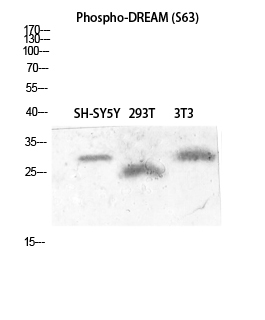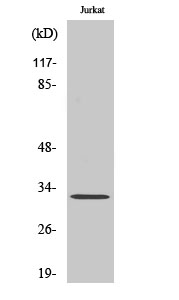Phospho Calsenilin/KCNIP3 (S63) Cell-Based Colorimetric ELISA Kit
- Catalog No.:KA1482C
- Applications:ELISA
- Reactivity:Human;Mouse
- Gene Name:
- KCNIP3
- Human Gene Id:
- 30818
- Human Swiss Prot No:
- Q9Y2W7
- Mouse Swiss Prot No:
- Q9QXT8
- Storage Stability:
- 2-8°C/6 months
- Other Name:
- Calsenilin (A-type potassium channel modulatory protein 3) (DRE-antagonist modulator) (DREAM) (Kv channel-interacting protein 3) (KChIP3)
- Detection Method:
- Colorimetric
- Background:
- function:Calcium-dependent transcriptional repressor that binds to the DRE element of genes including PDYN and FOS. Affinity for DNA is reduced upon binding to calcium and enhanced by binding to magnesium. Seems to be involved in nociception.,function:May play a role in the regulation of PSEN2 proteolytic processing and apoptosis. Together with PSEN2 involved in modulation of beta-amyloid formation.,function:Regulatory subunit of Kv4/D (Shal)-type voltage-gated rapidly inactivating A-type potassium channels. Probably modulates channels density, inactivation kinetics and rate of recovery from inactivation in a calcium-dependent and isoform-specific manner. In vitro, modulates KCND2/Kv4.2 and KCND3/Kv4.3 currents. Involved in KCND2 and probably KCND3 trafficking to the cell surface.,PTM:Palmitoylated. Palmitoylation enhances association with the plasma membrane.,PTM:Phosphorylation at Ser-63 inhibits cleavage by CASP3.,PTM:Proteolytically cleaved by caspase-3.,similarity:Belongs to the recoverin family.,similarity:Contains 4 EF-hand domains.,subcellular location:Also membrane-bound, associated with the plasma membrane (By similarity). In the presence of PSEN2 associated with the endoplasmic reticulum and Golgi.,subunit:Binds to DNA as a homomultimer. Dimerization is induced by binding to calcium. Component of heteromultimeric potassium channels. Interacts with KCND2 and KCND3 (By similarity). Interacts with the C-terminus of PSEN1 and PSEN2 and with PSEN2 CTF subunit. Associates with KCN1.,tissue specificity:Highly expressed in brain. Widely expressed at lower levels. Expression levels are elevated in brain cortex regions affected by Alzheimer disease.,
- Function:
- negative regulation of transcription from RNA polymerase II promoter, transcription, regulation of transcription, DNA-dependent, regulation of transcription from RNA polymerase II promoter, ion transport, cation transport, potassium ion transport, apoptosis, sensory perception, behavior, cell death, negative regulation of biosynthetic process,negative regulation of macromolecule biosynthetic process, negative regulation of macromolecule metabolic process,negative regulation of gene expression, regulation of cell death, programmed cell death, monovalent inorganic cation transport, death, negative regulation of transcription, sensory perception of pain, metal ion transport, negative regulation of cellular biosynthetic process, multicellular organismal response to stress, regulation of apoptosis,regulation of programmed cell death, regulation of neuron apoptosis, regulation of transcription
- Subcellular Location:
- Cytoplasm . Cell membrane ; Lipid-anchor . Endoplasmic reticulum . Golgi apparatus . Nucleus . Also membrane-bound, associated with the plasma membrane (PubMed:15485870). In the presence of PSEN2 associated with the endoplasmic reticulum and Golgi. The sumoylated form is present only in the nucleus. .
- Expression:
- Highly expressed in brain. Widely expressed at lower levels. Expression levels are elevated in brain cortex regions affected by Alzheimer disease.
- June 19-2018
- WESTERN IMMUNOBLOTTING PROTOCOL
- June 19-2018
- IMMUNOHISTOCHEMISTRY-PARAFFIN PROTOCOL
- June 19-2018
- IMMUNOFLUORESCENCE PROTOCOL
- September 08-2020
- FLOW-CYTOMEYRT-PROTOCOL
- May 20-2022
- Cell-Based ELISA│解您多样本WB检测之困扰
- July 13-2018
- CELL-BASED-ELISA-PROTOCOL-FOR-ACETYL-PROTEIN
- July 13-2018
- CELL-BASED-ELISA-PROTOCOL-FOR-PHOSPHO-PROTEIN
- July 13-2018
- Antibody-FAQs


